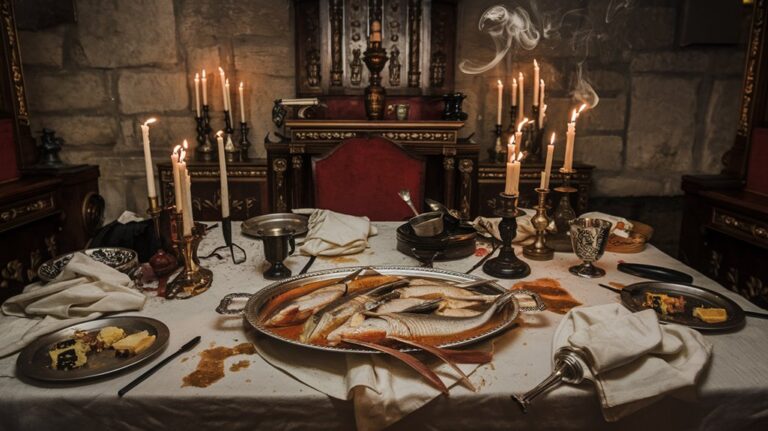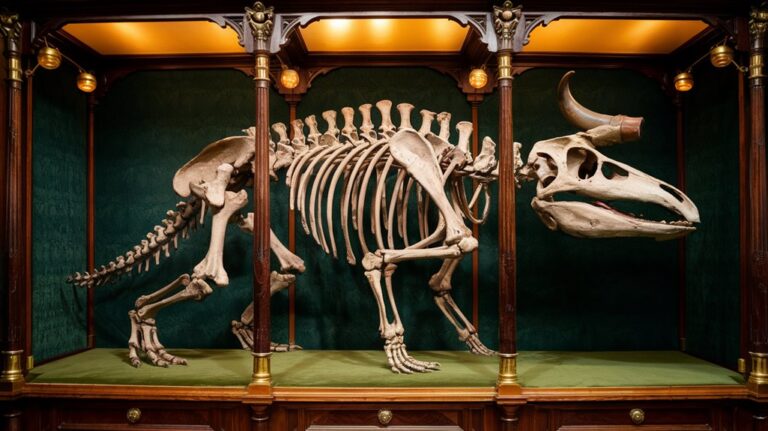Attila the Hun Reportedly Died From a Nosebleed
You've probably heard tales of history's most fearsome warriors meeting their end in epic battles, but Attila the Hun's death stands out for its peculiar simplicity. The notorious conqueror who terrorized both Eastern and Western Roman Empires allegedly succumbed to a nosebleed after his wedding feast in 453 CE. Yet, this seemingly straightforward account raises more questions than answers, and modern experts aren't entirely convinced by the ancient explanation of his demise.
The Mysterious Wedding Night Death

One of history's most enigmatic deaths occurred in 453 CE when Attila the Hun was found lifeless in his bed the morning after his wedding to Ildico.
Following an extravagant wedding feast filled with heavy drinking and celebration, the notorious warlord retired to his chambers with his new bride. The celebrations took place in the city of Sicambria where Attila maintained his court.
When guards discovered him the next morning, they found Attila drenched in blood from what appeared to be a simple nosebleed, with no other visible wounds on his body. Modern scholars suggest he may have suffered from a brain hemorrhage, which could explain the sudden fatal bleeding.
The blood symbolism of his death struck many as ironic – a feared conqueror who'd spilled rivers of blood across Europe died from his own blood loss.
You'll find Ildico's presence adds to the mystery, as guards discovered her weeping beside his body, leading to centuries of speculation about what really happened that night.
Historical Accounts and Medical Theories
While Byzantine historian Priscus provides our primary account of Attila's death, modern medical experts have proposed several theories about what truly killed the Hun leader.
You'll find that historical accuracy remains challenging since most records come from enemies or outsiders.
However, medical experts have identified these potential causes:
- Choking on blood from a severe nosebleed, intensified by heavy drinking
- Alcohol poisoning from excessive consumption during wedding celebrations
- Brain hemorrhage, with the nosebleed serving as a telling symptom
- Natural causes exacerbated by intoxication
While assassination theories persist, suggesting either Ildico or the Byzantine Emperor played a role, there's no concrete evidence to support foul play.
The combination of intoxication and a medical emergency remains the most plausible explanation for Attila's sudden demise on his wedding night.
His guards discovered his body with no visible wounds, leading many historians to rule out violent causes of death.
After his death, Attila's body was placed in a triple coffin made of gold, silver, and iron to represent his vast wealth and military power.
The Missing Tomb and Burial Rituals
Just as mysterious as Attila's cause of death is the location of his final resting place. Several tomb theories suggest he's buried in Hungary, possibly near the Danube River or beneath a farm field in the Hungarian lowlands.
The most intriguing theory claims the Huns diverted a river to conceal the burial site. The formation of Lake Tisza has further complicated efforts to locate the tomb.
The Hun's burial customs were elaborate and deeply rooted in pagan traditions. They laid Attila in three nested coffins made of gold, silver, and iron, symbolizing wealth, lunar connection, and strength. Scientists like Levente Szörényi actively search Hungarian sites to uncover the truth behind these legends.
During the ceremony, mourners gashed their faces and cut their hair while horsemen circled his tent. To guarantee absolute secrecy, the pallbearers were killed after placing valuable objects like weapons and tableware in the tomb.
Today, researchers continue searching underwater locations and analyzing medieval manuscripts for clues.
Legacy of the Hunnic Empire's Collapse
After Attila's death in 453 CE, the once-mighty Hunnic Empire rapidly disintegrated as his former adviser Ardaric led a decisive Germanic revolt against Hunnic rule.
The collapse sparked massive changes across Europe, with Germanic kingdoms rising from the empire's ashes. Attila's sons Elak and Dengzizish struggled bitterly for control, further weakening what remained of Hunnic power. Under his rule, the empire had included multiple ethnic groups including the Ostrogoths, Alans, and Gepids.
You'll find that Hunnic influence didn't vanish entirely, as their legacy lived on through:
- The Onogur Federation, which bridged Hunnic and Göktürk eras
- The emergence of Turkic cultures spreading westward into Eastern Europe
- The rise of Hunnicized peoples like the Bulgars and possibly the Magyars
- The reshaping of Europe's political landscape as former Hunnic subjects established new kingdoms
The aftermath of this collapse contributed to the Western Roman Empire's fall, as various tribes, including the Ostrogoths and Vandals, carved out their own territories from former Roman lands.
The Final Campaign That Never Was

Before his unexpected death in 453 CE, Attila had set his sights on one final, ambitious campaign against Italy and the Western Roman Empire.
You'd have witnessed his plans to cross the Alps and terrorize the Italian peninsula, ultimately aiming to capture Rome and crown himself Emperor. After recovering from previous setbacks, including the pivotal Battle of the Catalaunian Plains, Attila was determined to overcome Roman resilience and restore his reputation for invincibility. His forces had already demonstrated their destructive potential when they sacked Metz and devastated numerous cities across Gaul.
However, this final campaign would never materialize. His empire had already shown signs of weakening after the failures in Gaul, where Aetius' diplomatic maneuvering and military strategy had successfully halted Hunnic expansion westward. Legend says he was dissuaded from attacking Rome after a meeting with the Pope.
The campaign remained just a plan, as Attila's sudden death would mark the beginning of his empire's rapid dissolution.










